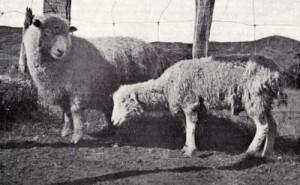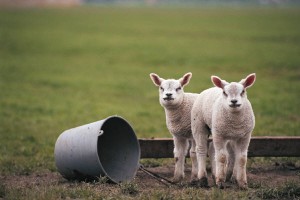Sheep Diseases
Cobalt Deficiency in Sheep
Also known as: White Liver Disease
Many soils and pastures across the world are deficient in cobalt, causing a deficiency in sheep grazing those pastures. Lambs, after weaning, are particularly susceptible to deficiency or ‘pine’, exhibiting a watery discharge from the eyes, reduced growth rates, debility and emaciation (Henderson, 1990; Vellema et al., 1997; Suttle, 2010). In severe cases there is a loss of appetite, anaemia and eventually death. Resistance to diseases such as gastro-intestinal parasites may also be impaired (Ferguson et al., 1989; Vellema et al., 1996). The livers of the lambs become pale, swollen and friable through the accumulation of lipids (ovine white liver disease) (Kennedy et al., 1994a; Kennedy et al., 1994b). Adult ewes affected by cobalt deficiency are less common, but may show secondary effects in the form of infertility and poor mothering ability, and there is evidence that cobalt deficiency in pregnant ewes reduces the viability of their offspring (Fisher and MacPherson, 1991).
| Disorder | Time course | Principal feature | Vulnerable animals |
| Ill-thrift | Semi-chronic | Slow growth at pasture | Young lambs |
| ‘Pine’ | Chronic | Weight loss | Lambs and ewes |
| White-liver disease | Semi-acute | Fatty liver | Lambs and Angora kids |
| ‘Hepatic lipidosis’ | Semi-acute | Fatty liver | Goat kids on low protein diets |
The table above is from Suttle (2010) and summarizes the main cobalt deficiency disorders found in sheep and goats
Around the world
Cobalt deficiency has been historically recorded as ‘coast disease’ of sheep in South Australia, ‘wasting disease’ of cattle in Western Australia, ‘cobalt pine’ in north-west Scotland, ‘bush-sickness’ in New Zealand, ‘salt sickness’ in Florida, ‘Nakuruitis’ in Kenya, ‘lecksucht’ in the Netherlands and Germany and ‘Grand Traverse disease’ in Michigan (Suttle, 2010).
How do sheep use cobalt?
The only known biological role for cobalt is as a constituent of vitamin B12, which has two major coenzyme functions in the body and is used in the liver for energy production. Methylcobalamin promotes methionine synthesis. Methionine supply ultimately influences DNA synthesis (Kennedy et al., 1992; Kennedy et al., 1994a). Deoxyadenosylcobalamin performs a key role in the energy metabolism of ruminants by facilitating the metabolism of propionate, which is an important precursor of glucose in ruminants (Kennedy et al., 1991).
Ruminants rely entirely on their rumen microbes to incorporate cobalt into vitamin B12. The vitamin B12 status of the animals is therefore not entirely dependent on the level of cobalt in the soil and diet (Reid and Horvath, 1980). The efficiency with which cobalt is incorporated into vitamin B12 by the rumen microbes, the efficiency of absorption and the metabolic demands of the coenzyme-dependent functions are also important factors. Dietary levels of cobalt below 0.08 mg (1.4 m mol)/kg DM are regarded as inadequate, but are not invariably associated with loss of production.
With regard to the effect of cobalt deficiency on disease resistance and immuno-competence, there are reports of impaired leucocyte and lymphocyte responses to in vitro challenges in cobalt deficient sheep, but their relevance to disease resistance in vivo is unproven (Suttle and Jones, 1989). Cobalt deficiency has reduced lamb survival and increased susceptibility to parasitic infection transiently in cattle and lastingly in sheep.
There can be considerable annual variation in incidence of deficiency on the same farm (Lee, 1951). Sheep and Angora goats may be particularly susceptible because of their high requirements of fleece growth (Suttle, 2012). Intensively managed, fast-growing lambs will have higher requirements for cobalt and hence may be more susceptible. Young male lambs can also be particularly vulnerable within a flock (Shallow et al., 1989).
Soil cobalt levels
There appears to be annual variation in the extent of cobalt deficiency problems, and although areas of known cobalt deficiency are documented, the relationship between soil, plant and animal cobalt status is complex and therefore it is difficult to predict problem years (Reid and Horvath, 1980). Soil pH, soil compaction and rapidly growing pastures can all affect the uptake of cobalt by herbage. Pasture cobalt is reduced as the soil pH rises and increased by poor soil drainage and herbage concentrations increases if plants are contaminated with soil (Suttle, 2010). Ingested soil can be a significant source of cobalt for grazing sheep (Grace, 2006). Soils with high molybdenum content can induce cobalt deficiency (Suttle et al., 1975). Soil values of cobalt below 0.3 mg (5.1 m mol)/kg soil are regarded as ‘deficient’.
Methods of Control and Prevention
Sheep need a continuous supply of cobalt, as the body’s capacity to store vitamin B12 is limited. Whether cobalt deficiency is the reason behind the animal’s poor performance can be established by measuring the plasma B12 level of the lamb in question. There is considerable variation in the cobalt concentrations in pasture species with clovers having higher levels than ryegrass (Minson, 1990; Suttle, 2010). Cereals have low concentrations, particularly whole grains. The lower productivity of grassland and forage areas under low input management means that the cobalt concentration in the plants is likely to be higher in cobalt deficient areas than in more intensively managed systems. The use of leguminous plants in pastures will also improve the mineral content of the sward.
Cobalt deficiency is very difficult to prevent by methods of management. Farmers in areas where the soil is very deficient may have to import feed stuff from areas where cobalt deficiency is not a problem, which may be counter to our sustainability goals. Geo-chemical survey techniques are now being used to assess the risk of soil mineral deficiencies, including cobalt (Lark et al., 2014).
Several methods of supplying cobalt are used in conventional sheep farming. They include: supplementation of concentrate feeds, cobalt supplementation in salt licks/ free access minerals, oral administration of cobalt slow-release pellets/boluses, periodic oral drenching with cobalt and application of cobalt sulphate directly to pasture. The application of cobalt sulphate to pasture used to be one of the most commonly used methods of preventing cobalt deficiency (Paterson et al., 1989). The increased price of cobalt salts has tended to moderate their use as fertilisers and applying it in strips can save costs. Adding cobalt salts or oxides to pasture may also stimulate legume growth rates. The frequency of fertilizing will be very dependent on soil type and management (Suttle, 2010). Fertilizer treatment is unreliable on soils that are highly alkaline and those that have been recently limed. The efficiency of cobalt fertilizers as a means of alleviating problems of cobalt deficiency depends on the manganese content of the soil. Soils high in manganese oxides will fix cobalt in a form that is unavailable to grazing animals (Adams et al., 1969).
Oral drenching with cobalt sulphate solutions is a good alternative, but costly in labour and impracticable on many farms, as it needs to be repeated weekly or fortnightly. Oral drenching with anthelmintics containing cobalt is becoming increasingly popular in conventional farming, with many anthelmintics on the market containing cobalt and selenium (Bremner et al., 1988). This method is not applicable in organic farming as the prophylactic use of anthelmintics is usually not permitted. It is also important to know the resistance status of your farm, as the principle group of anthelmintics that is combined with cobalt is 1-BZ (white drenches), which has the highest level of resistance of the drench types in the UK (80% of UK farms have 1-BZ resistance (Source: SCOPS). Generally it is not advisable to use an anthelmintic for anything other than the narrow spectrum activity for which it is designed.
Slow release boluses containing several minerals including cobalt slowly dissolve in the reticulo-rumen and release cobalt on a continuous basis, which is the ideal situation for the rumen microorganisms’ requirements. Cobalt oxide boluses should not be used in lambs before weaning, as an insoluble coating of calcium phosphate can form on the bolus, preventing the release of cobalt. Castrated male lambs have been shown to respond better to glass bolus supplementation than ewe lambs (Shallow et al., 1989).
Free access minerals are not a very suitable method of supplying cobalt because of variable intakes. Supplements are a valuable method for ensuring the correct cobalt status of home mixed rations. Mineral mixes containing as little as 680 m mol (40 mg) Co/kg will provide adequate Co intake when they are included at a rate of 25 kg per tonne, provided the concentrate forms at least 10 per cent of the total food intake. Unfortunately, lambs are rarely fed concentrates during high-risk periods for cobalt.
Grazing management has been shown to have an impact. Short heavily-grazed pastures may reduce the severity of cobalt-deficiency disease and heavy grazing, which increases the cobalt intake from soil contaminated pastures, can also offer some protection (Andrews et al., 1958).
For organic farmers
Organic farming standards permit mineral supplementation of animals only where trace element requirements cannot be met by the practice of organic husbandry. Pasture treatment with cobalt chloride or sulphate, or the use of slow release boluses containing cobalt, would be the preferred options. Boluses satisfy the animals’ requirements for cobalt plus the need for animal handling would be minimal. Mineral licks would also be acceptable although intakes can vary considerably between animals.
Methods of Treatment
Cobalt deficiency can be established by measuring blood plasma B12 level. The most immediate and short term response to symptoms of cobalt deficiency will be obtained by injecting commercially available cyanocobalamin, straight vitamin B12 or oral drench of cobalt sulphate.
It should be possible to prevent the use of more than one injection by changing to other methods of prevention, such as pasture treatment with a cobalt salt or the use of boluses. Treatment by oral dosing with cobalt sulphate gives a dramatic increase in the vitamin B12 synthesis of the rumen microbes. Veterinary advice should be sought for all veterinary treatments.
Good Practice based on Current Knowledge
- Establish whether the soil is deficient in cobalt.
- Establish whether cobalt deficiency is the reason why the lambs are not flourishing. Blood sample a proportion of the flock for analysis.
- Use plants in the sward (e.g. legumes) which contain a higher level of minerals, including cobalt.
- Use slower growing breeds of sheep.
- If necessary, control and prevent cobalt deficiency in the animals with a cobalt-containing bolus, in-feed minerals, drenching or mineral licks, or by treating the pasture with a cobalt salt.
See also Cobalt deficiency in cattle and Sheep Nutrition for further information.


 American English
American English



Comments are closed.